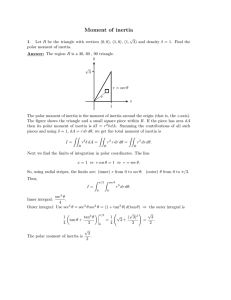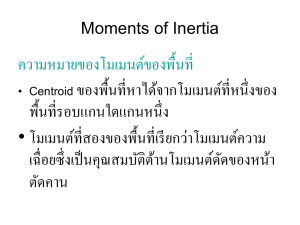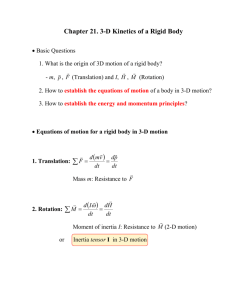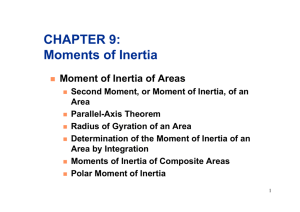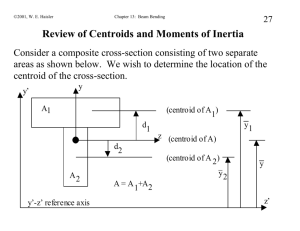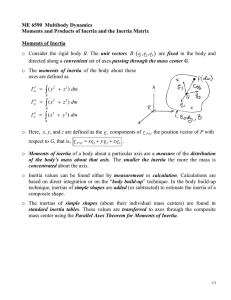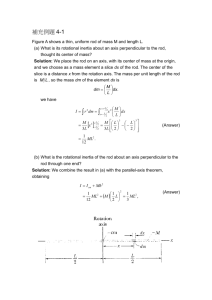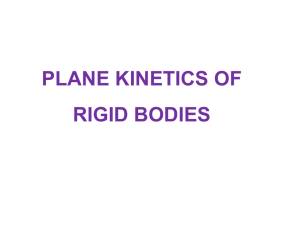Chap08 Moment of Inertia
advertisement
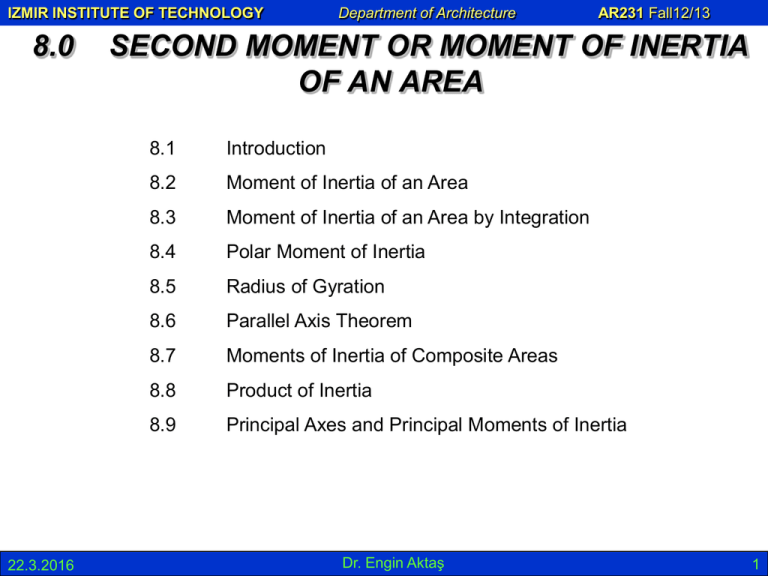
IZMIR INSTITUTE OF TECHNOLOGY 8.0 22.3.2016 Department of Architecture AR231 Fall12/13 SECOND MOMENT OR MOMENT OF INERTIA OF AN AREA 8.1 Introduction 8.2 Moment of Inertia of an Area 8.3 Moment of Inertia of an Area by Integration 8.4 Polar Moment of Inertia 8.5 Radius of Gyration 8.6 Parallel Axis Theorem 8.7 Moments of Inertia of Composite Areas 8.8 Product of Inertia 8.9 Principal Axes and Principal Moments of Inertia Dr. Engin Aktaş 1 IZMIR INSTITUTE OF TECHNOLOGY Department of Architecture AR231 Fall12/13 8.1. Introduction • Forces which are proportional to the area or volume over which they act but also vary linearly with distance from a given axis. - the magnitude of the resultant depends on the first moment of the force distribution with respect to the axis. - The point of application of the resultant depends on the second moment of the distribution with respect to the axis. • Herein methods for computing the moments and products of inertia for areas and masses will be presented 22.3.2016 Dr. Engin Aktaş 2 IZMIR INSTITUTE OF TECHNOLOGY Department of Architecture AR231 Fall12/13 8.2. Moment of Inertia of an Area • Consider distributed forces F whose magnitudes are proportional to the elemental areas A on which they act and also vary linearly with the distance of A from a given axis. • Example: Consider a beam subjected to pure bending. Internal forces vary linearly with distance from the neutral axis which passes through the section centroid. F kyA R k y dA 0 y dA Qx first moment 2 M k y 2 dA y dA second moment • Example: Consider the net hydrostatic force on a submerged circular gate. F pA yA R y dA M x y 2 dA 22.3.2016 Dr. Engin Aktaş 3 IZMIR INSTITUTE OF TECHNOLOGY Department of Architecture AR231 Fall12/13 8.3.Moment of Inertia of an Area by Integration • Second moments or moments of inertia of an area with respect to the x and y axes, I x y 2 dA I y x 2 dA • Evaluation of the integrals is simplified by choosing dA to be a thin strip parallel to one of the coordinate axes. • For a rectangular area, h I x y dA y 2bdy 13 bh3 2 0 • The formula for rectangular areas may also be applied to strips parallel to the axes, dI x 13 y 3dx 22.3.2016 Dr. Engin Aktaş dI y x 2 dA x 2 y dx 4 IZMIR INSTITUTE OF TECHNOLOGY Department of Architecture AR231 Fall12/13 8.4. Polar Moment of Inertia • The polar moment of inertia is an important parameter in problems involving torsion of cylindrical shafts and rotations of slabs. J 0 r 2 dA • The polar moment of inertia is related to the rectangular moments of inertia, J 0 r 2 dA x 2 y 2 dA x 2 dA y 2 dA I y Ix 22.3.2016 Dr. Engin Aktaş 5 IZMIR INSTITUTE OF TECHNOLOGY Department of Architecture AR231 Fall12/13 8.5. Radius of Gyration of an Area • Consider area A with moment of inertia Ix. Imagine that the area is concentrated in a thin strip parallel to the x axis with equivalent Ix. I I x k x2 A kx x A kx = radius of gyration with respect to the x axis • Similarly, Iy k y2 A ky J O kO2 A kO Iy A JO A kO2 k x2 k y2 22.3.2016 Dr. Engin Aktaş 6 IZMIR INSTITUTE OF TECHNOLOGY Department of Architecture AR231 Fall12/13 Examples SOLUTION: • A differential strip parallel to the x axis is chosen for dA. dI x y 2dA dA l dy • For similar triangles, Determine the moment of inertia of a triangle with respect to its base. l h y b h l b h y h dA b h y dy h • Integrating dIx from y = 0 to y = h, h y bh 2 I x y dA y b dy hy y 3 dy h h0 0 2 h 2 h b y3 y 4 h h 3 4 0 22.3.2016 Dr. Engin Aktaş bh3 I x 12 7 IZMIR INSTITUTE OF TECHNOLOGY Department of Architecture AR231 Fall12/13 SOLUTION: • An annular differential area element is chosen, dA 2 u du dJ O u 2dA r r J O dJ O u 2 u du 2 u 3du 2 0 0 JO a) Determine the centroidal polar moment of inertia of a circular area by direct integration. 2 r4 • From symmetry, Ix = Iy, JO I x I y 2I x b) Using the result of part a, determine the moment of inertia of a circular area with respect to a diameter. 22.3.2016 2 r 4 2I x I diameter I x Dr. Engin Aktaş 4 r4 8 IZMIR INSTITUTE OF TECHNOLOGY Department of Architecture AR231 Fall12/13 8.6. Parallel Axis Theorem • Consider moment of inertia I of an area A with respect to the axis AA’ I y 2 dA • The axis BB’ passes through the area centroid and is called a centroidal axis. I y 2 dA y d 2 dA y 2 dA 2d y dA d 2 dA I I Ad 2 22.3.2016 Dr. Engin Aktaş parallel axis theorem 9 IZMIR INSTITUTE OF TECHNOLOGY Department of Architecture AR231 Fall12/13 • Moment of inertia IT of a circular area with respect to a tangent to the circle, I T I Ad 2 14 r 4 r 2 r 2 54 r 4 • Moment of inertia of a triangle with respect to a centroidal axis, I AA I BB Ad 2 I BB I AA Ad 2 1 bh3 12 2 1 1 2 bh 3 h 1 bh3 36 22.3.2016 Dr. Engin Aktaş 10 IZMIR INSTITUTE OF TECHNOLOGY Department of Architecture AR231 Fall12/13 8.7. Moments of Inertia of Composite Areas • The moment of inertia of a composite area A about a given axis is obtained by adding the moments of inertia of the component areas A1, A2, A3, ... , with respect to the same axis. 22.3.2016 Dr. Engin Aktaş 11 IZMIR INSTITUTE OF TECHNOLOGY Department of Architecture AR231 Fall12/13 Example 225 mm 20 mm 358 mm SOLUTION: • Determine location of the centroid of composite section with respect to a coordinate system with origin at the centroid of the beam section. • Apply the parallel axis theorem to determine moments of inertia of beam section and plate with respect to 172 mm composite section centroidal axis. The strength of a W360x57 rolled steel beam is increased by attaching a • Calculate the radius of gyration from the 225x20 mm plate to its upper flange. moment of inertia of the composite section. Determine the moment of inertia and radius of gyration with respect to an axis which is parallel to the plate and passes through the centroid of the section. 22.3.2016 Dr. Engin Aktaş 12 IZMIR INSTITUTE OF TECHNOLOGY 225 mm 20 mm Department of Architecture AR231 Fall12/13 SOLUTION: • Determine location of the centroid of composite section with respect to a coordinate system with origin at the centroid of the beam section. 358 mm 172 mm A 225 mm20 mm 4500 mm2 1 1 y 358 mm 20 mm 189 mm 2 2 Section 189 mm 3 mm3 y , in. mm yA, in Plate 6.75 7189 .425 50 .12 x 103 850.5 4500 7230 Beam Section 11.20 0 0 17.95 50.12 x 103 A 11730 yA 850.5 Y A yA 22.3.2016 2 2 mm A, in yA 850.5 10 Y A 11730 Dr. Engin Aktaş 3 72.51 mm. 13 IZMIR INSTITUTE OF TECHNOLOGY 225 mm 20 mm Department of Architecture AR231 Fall12/13 • Apply the parallel axis theorem to determine moments of inertia of beam section and plate with respect to composite section centroidal axis. I x,beam section I x AY 2 160.2 106 723072.51 2 358 mm 198.2 10 4 I x,plate I x Ad 2 121 22520 4500189 72.51 3 2 61.2 106 mm 4 172 mm I x I x,beam section I x,plate 192.6 106 61.2 106 I x 254 106 mm4 189 mm • Calculate the radius of gyration from the moment of inertia of the composite section. k x 22.3.2016 I x 253.8 106 mm 4 A 11730 mm 2 Dr. Engin Aktaş k x 147.1 mm. 14 IZMIR INSTITUTE OF TECHNOLOGY Department of Architecture AR231 Fall12/13 Example SOLUTION: • Compute the moments of inertia of the bounding rectangle and half-circle with respect to the x axis. • The moment of inertia of the shaded area is obtained by subtracting the moment of inertia of the half-circle from the moment of inertia of the rectangle. Determine the moment of inertia of the shaded area with respect to the x axis. 22.3.2016 Dr. Engin Aktaş 15 IZMIR INSTITUTE OF TECHNOLOGY Department of Architecture AR231 Fall12/13 SOLUTION: • Compute the moments of inertia of the bounding rectangle and half-circle with respect to the x axis. Rectangle: I x 13 bh3 13 240120 138.2 106 mm 4 Half-circle: moment of inertia with respect to AA’, I AA 18 r 4 18 904 25.76 106 mm 4 moment of inertia with respect to x’, 4r 4 90 a 38.2 mm 3 3 b 120 - a 81.8 mm A 12 r 12 90 2 2 12.72 103 mm 2 22.3.2016 I x I AA Aa 2 25.76 106 12.72 103 7.20 106 mm 4 moment of inertia with respect to x, I x I x Ab 2 7.20 106 12.72 103 81.82 92.3 106 mm 4 Dr. Engin Aktaş 16 IZMIR INSTITUTE OF TECHNOLOGY Department of Architecture AR231 Fall12/13 • The moment of inertia of the shaded area is obtained by subtracting the moment of inertia of the half-circle from the moment of inertia of the rectangle. Ix 138.2 106 mm 4 92.3 106 mm 4 I x 45.9 106 mm 4 22.3.2016 Dr. Engin Aktaş 17 IZMIR INSTITUTE OF TECHNOLOGY Department of Architecture AR231 Fall12/13 8.8. Product of Inertia • Product of Inertia: I xy xy dA • When the x axis, the y axis, or both are an axis of symmetry, the product of inertia is zero. • Parallel axis theorem for products of inertia: I xy I xy xyA 22.3.2016 Dr. Engin Aktaş 18 IZMIR INSTITUTE OF TECHNOLOGY Department of Architecture AR231 Fall12/13 8.9. Principal Axes and Principal Moments of Inertia Given I x y 2 dA I y x 2 dA I xy xy dA we wish to determine moments and product of inertia with respect to new axes x’ and y’. Note: x x cos y sin y y cos x sin 22.3.2016 • The change of axes yields Ix I y Ix I y I x cos 2 I xy sin 2 2 2 Ix I y Ix I y I y cos 2 I xy sin 2 2 2 Ix I y I xy sin 2 I xy cos 2 2 • The equations for Ix’ and Ix’y’ are the parametric equations for a circle, I x I ave 2 I x2y R 2 Ix I y I ave 2 Ix I y 2 I xy R 2 • The equations for Iy’ and Ix’y’ lead to the same circle. Dr. Engin Aktaş 19 IZMIR INSTITUTE OF TECHNOLOGY Department of Architecture AR231 Fall12/13 • At the points A and B, Ix’y’ = 0 and Ix’ is a maximum and minimum, respectively. I max, min I ave R tan 2 m 2 I xy Ix I y • The equation for Qm defines two angles, 90o apart which correspond to the principal axes of the area about O. I x I ave 2 I x2y R 2 I ave 22.3.2016 Ix I y 2 Ix I y 2 I xy R 2 • Imax and Imin are the principal moments of inertia of the area about O. Dr. Engin Aktaş 20 IZMIR INSTITUTE OF TECHNOLOGY Department of Architecture AR231 Fall12/13 Example SOLUTION: • Determine the product of inertia using direct integration with the parallel axis theorem on vertical differential area strips • Apply the parallel axis theorem to evaluate the product of inertia with respect to the centroidal axes. Determine the product of inertia of the right triangle (a) with respect to the x and y axes and (b) with respect to centroidal axes parallel to the x and y axes. 22.3.2016 Dr. Engin Aktaş 21 IZMIR INSTITUTE OF TECHNOLOGY Department of Architecture AR231 Fall12/13 SOLUTION: • Determine the product of inertia using direct integration with the parallel axis theorem on vertical differential area strips x x y h1 dA y dx h1 dx b b x xel x yel 12 y 12 h1 b Integrating dIx from x = 0 to x = b, b I xy dI xy xel yel dA x 0 b 1 2 2 x h 1 dx b 2 2 b x 2 x3 x 4 x 2 x x h dx h 2 2 b 2b 2 0 4 3b 8b 0 2 3 1 b 2h 2 I xy 24 22.3.2016 Dr. Engin Aktaş 22 IZMIR INSTITUTE OF TECHNOLOGY Department of Architecture AR231 Fall12/13 • Apply the parallel axis theorem to evaluate the product of inertia with respect to the centroidal axes. x 13 b y 13 h With the results from part a, I xy I xy x yA 13 h12 bh 1 b2h 2 1 b I xy 24 3 1 b 2h 2 I xy 72 22.3.2016 Dr. Engin Aktaş 23 IZMIR INSTITUTE OF TECHNOLOGY Department of Architecture AR231 Fall12/13 Example SOLUTION: • Compute the product of inertia with respect to the xy axes by dividing the section into three rectangles and applying the parallel axis theorem to each. • Determine the orientation of the principal axes (Eq. 9.25) and the principal moments of inertia (Eq. 9. 27). For the section shown, the moments of inertia with respect to the x and y axes are Ix = 10.38 in4 and Iy = 6.97 in4. Determine (a) the orientation of the principal axes of the section about O, and (b) the values of the principal moments of inertia about O. 22.3.2016 Dr. Engin Aktaş 24 IZMIR INSTITUTE OF TECHNOLOGY Department of Architecture AR231 Fall12/13 SOLUTION: 76 mm • Compute the product of inertia with respect to the xy axes by dividing the section into three rectangles. 13 mm Apply the parallel axis theorem to each rectangle, 102 mm I xy I xy x yA 13 mm 76 mm 31.5 mm 44.5 mm Note that the product of inertia with respect to centroidal axes parallel to the xy axes is zero for each rectangle. Rectangle I II III Area, mm 2 x , mm. 988 31.5 988 0 988 31.5 44.5 mm y , mm. 44.5 0 44.5 x yA, mm 4 1384929 0 1384929 xyA 2769858 I xy xyA 2770000mm4 31.5 mm 22.3.2016 Dr. Engin Aktaş 25 IZMIR INSTITUTE OF TECHNOLOGY Department of Architecture AR231 Fall12/13 tan 2 m • Determine the orientation of the principal axes by m = 127.5o the principal moments of inertia by 2 I xy Ix I y I max, min I ave R I x I ave 2 I x2y R 2 m = I ave 37.5o I max, min Ix Iy 2 Ix I y 2 I xy R 2 2 m 74.9 and 254.9 4 m 37.5 and m 127.5 Ix I y I xy2 2 2 2 4.42 106 2.93 106 4.42 10 2.93 10 2.77 106 2 2 6 2 2.77 106 tan 2 m 3.72 6 6 Ix Iy 4.42 10 2.93 10 I y 2.93 106 mm 4 I xy 2.77 10 mm 2 2 I xy I x 4.42 106 mm 4 6 Ix I y 6 2 I a I max 6.54 mm 4 I b I min 8.07 mm 4 22.3.2016 Dr. Engin Aktaş 26
